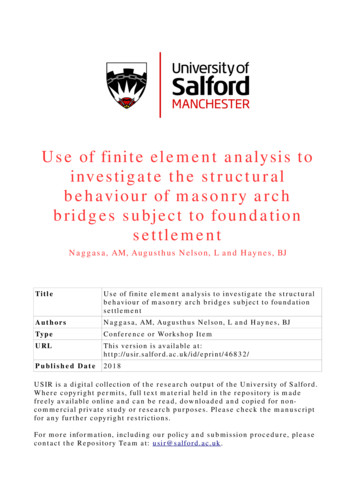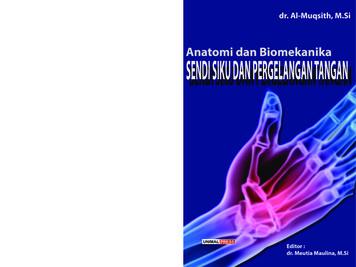Masonry Design - Faculty.arch.tamu.edu
ARCH 331 Note Set 28.1 Su2017abn Masonry Design Notation: A An name for area net area, equal to the gross area subtracting any reinforcement Anv net shear area of masonry As area of steel reinforcement in masonry design Ast area of steel reinforcement in masonry column design ACI American Concrete Institute ASCE American Society of Civil Engineers b width, often cross-sectional C name for a compression force Cm compression force in the masonry for masonry design CMU shorthand for concrete masonry unit d effective depth from the top of a reinforced masonry beam to the centroid of the tensile steel e eccentric distance of application of a force (P) from the centroid of a cross section fa axial stress fb bending stress fm calculated compressive stress in masonry fm masonry design compressive stress fs stress in the steel reinforcement for masonry design fv shear stress Fa allowable axial stress Fb allowable bending stress Fs allowable tensile stress in reinforcement for masonry design Ft allowable tensile stress Fv allowable shear stress Fvm allowable shear stress of the masonry Fvs allowable shear stress of the shear reinforcement h name for height effective height of a wall or column Ix moment of inertia with respect to an x-axis j multiplier by effective depth of masonry section for moment arm, jd k multiplier by effective depth of masonry section for neutral axis, kd L name for length or span length M internal bending moment type of masonry mortar Mm moment capacity of a reinforced masonry beam governed by steel stress Ms moment capacity of a reinforced masonry beam governed by masonry stress MSJC Masonry Structural Joint Council n modulus of elasticity transformation coefficient for steel to masonry n.a. shorthand for neutral axis (N.A.) N type of masonry mortar NCMA National Concrete Masonry Association O type of masonry mortar P name for axial force vector Pa allowable axial load in columns r radius of gyration S section modulus type of masonry mortar Sx section modulus with respect to an x-axis t name for thickness T name for a tension force Ts tension force in the steel reinforcement for masonry design TMS The Masonry Society w name for distributed load 1 coefficient for determining stress block height, c, in masonry LRFD design m strain in the masonry s strain in the steel 439 reinforcement ratio in masonry design
ARCH 331 Note Set 28.1 Su2017abn Reinforced Masonry Design Structural design standards for reinforced masonry are established by the Masonry Standards Joint Committee consisting of ACI, ASCE and The Masonry Society (TMS), and presents allowable stress design as well as limit state (strength) design. Materials f’m masonry prism compressive strength from testing Reinforcing steel grades are the same as those used for reinforced concrete beams. Units can be brick, concrete or stone. Mortar consists of masonry cement, lime, sand, and water. Grades are named from the word MASONWORK, with average strengths of 2500psi, 1800 psi, 750 psi, 350 psi, and 75 psi, respectively. Grout is a flowable mortar, usually with a high amount of water to cement material. It is used to fill voids and bond reinforcement. Clay and concrete masonry units are porous, and their durability with respect to weathering is an important consideration. The amount of water in the mortar is important as well as the absorption capacity of the units for good bond; both for strength and for weatherproofing. Because of the moisture and tendency for shrinkage and swelling, it is critical to provide control joints for expansion and contraction. Sizes Common sizes for clay brick and concrete masonry units (CMU) are shown in the figure, along with definitions. Standard Modular Clay Brick 4 in. Normal Clay Brick Typical section properties for CMU’s are provided for reference at the end of the document. Two Core Stretch Unit Three Core Stretch Unit Allowable Stress Design For unreinforced masonry, like masonry walls, tension stresses are allowed in flexure. Masonry walls typically see compression stresses too. 440
ARCH 331 Note Set 28.1 Su2017abn For reinforced masonry, the steel is presumed to resist all tensile stresses and the tension in the masonry is ignored. Factors of Safety are applied to the limit stresses for allowable stress values: bending (unreinforced) Fb 1/3 f m bending (reinforced) bending (tension/unreinforced) beam shear (unreinforced for flexure) Fb 0.45 f m table 2.2.3.2 Fv 1.5 f m 120 psi beam shear (reinforced) – M/(Vd) 0.25 Fv 3.0 beam shear (reinforced) – M/(Vd) 1.0 Grades 40 or 50 reinforcement Grades 60 reinforcement Wire joint reinforcement Fv 2.0 f m Fs 20 ksi Fs 32 ksi Fs 30 ksi f m where f’m specified compressive strength of masonry Internal Equilibrium for Bending Cm compression in masonry stress x area f m b(kd) 2 Ts tension in steel stress x area Asfs STRAIN m b Cm Ts and STRESS fm Cm fmb(kd)/2 kd d Mm Ts(d-kd/3) Ts(jd) Ms Cm(jd) n.a. t grout unit As jd s fs/n BIA Teknote 17 series where fm compressive stress in the masonry from flexure fs tensile stress in the steel reinforcement kd the height to the neutral axis b width of stress area d effective depth of section depth to n.a. of reinforcement jd moment arm from tension force to compression force As area of steel n Es/Em used to transform steel to equivalent area of masonry for elastic stresses reinforcement ratio 441 Ts Asfs M
ARCH 331 Note Set 28.1 Su2017abn Criteria for Beam Design For flexure design: kd M m f mb jd 0.5 f m bd 2 jk or M s As f s jd ρbd 2 jf s 2 The design is adequate when f b Fb in the masonry and f s Fs .in the steel. Shear stress is determined by fv V/Anv where Anv is net shear area. Shear strength is determined from the shear capacity of the masonry and the stirrups: Fv Fvm Fvs. Stirrup spacings are limited to d/2 but not to exceed 48 in. where: Fvm 1 M 4.0 1.75 2 Vd P f m 0.25 An A Fd Fvs 0.5 v s Anv s where M/(Vd) is positive and cannot exceed 1.0 (Fv 3.0 f m when M/(Vd) 0.25 ) (Fv 2.0 f m when M/(Vd) 1.0.) Values can be linearly interpolated. Load and Resistance Factor Design The design methodology is similar to reinforced concrete ultimate strength design. It is useful with high shear values and for seismic design. The limiting masonry strength is 0.80f’m. Criteria for Column Design (Masonry Joint Code Committee) Building Code Requirements and Commentary for Masonry Structures define a column as having b/t 3 and h/t 4. where b width of the “wall” t thickness of the “wall” h height of the “wall” A slender column has a minimum dimension of 8” on one side and h/t 25. Columns must be reinforced, and have ties. A minimum eccentricity (causing bending) of 0.1 times the side dimension is required. Allowable Axial Load for Reinforced Masonry h 2 Pa 0.25 f m An 0.65 Ast Fs 1 for h/t 99 140r 70r Pa 0.25 f m An 0.65 Ast Fs h 2 for h/t 99 442
ARCH 331 Note Set 28.1 Su2017abn Allowable Axial Stresses for Unreinforced Masonry (walls only) h 2 for h/t 99 Fa 0.25 f m 1 140r 70r Fa 0.25 f m h 2 for h/t 99 where h effective length r radius of gyration An effective (or net) area of masonry Ast area of steel reinforcement f m specified masonry compressive strength Fs allowable compressive stress in column reinforcement with lateral confinement. The least radius of gyration can be found with as: r I for a rectangle with side dimensions of b & d A db 3 2 12 b b bd 12 12 where b is the smaller of the two side dimensions. Combined Stresses When maximum moment occurs somewhere other than at the end of the column or wall, a “virtual” eccentricity can be determined from e M/P. Masonry Columns and Walls There are no modification factors, but in addition to satisfying fa f b 1.0 , the tensile stress Fa Fb cannot exceed the allowable: f b f a Ft or the compressive stress exceed allowable for reinforced masonry: f a f b Fb provided f a Fa . 443
ARCH 331 Note Set 28.1 Su2017abn Example 1 Determine if the unreinforced CMU wall can sustain its loads with the wind. Specify a mortar type and unit strength per MSJC. M fa f fb Fb 1 3 f m b 1.0 S Fa Fb 2 h h Fa 0.25 f m 1 for 99 r 140r fa P A 14-1B: 2 h 70r Fa 0.25 f m for 99 r h 12 12in 2 h 12 ft( 12in ) 44.9 so Fa 0.25 f m 1 0.224 f m r 3.21in 140 3.21in fa 3.21” 4k ( 1000 lb k ) 133 psi 30 in 2 (1 ft kips/ft2) (ft) (in/ft) Mmax Pe fb 1/3f’m f’m 154/(1/3) 462 psi M Pe/2 Mmax wL2/8 psi 1; 0.224 Moment distribution Moment distribution from from eccentricity distributed wind load 1056 psi 25 psi 0.224 1038 psi 444 f’m 1056 psi (governs)
ARCH 331 Note Set 28.1 445 Su2017abn
Masonry Design Notation: A name for area A n net area, equal to the gross area subtracting any reinforcement . masonry column design ACI American Concrete Institute ASCE American Society of Civil Engineers b width, often cross-sectional C name for a compression force C m compression force in the masonry for masonry design CMU .
Mechanical Engineering Office Building Suite 200 979.845.1252 mechanical-undergradprogram@tamu.edu Undergraduate Program Director Ms. Heather Lewis, hlewis@tamu.edu Academic Advisors Ms. Jennifer Desai, jdesai@tamu.edu Ms. Madison Heyman, mad97hey@tamu.edu Ms. Regina Muir, rmuir@tamu.edu Dr. Ashley Schmitt, schmittae@tamu.edu
Masonry lintel design is a critical part of an efficient structural masonry solution. The design of masonry . Figure 2: Steel lintel at bearing Figure 3: Masonry lintel intersection masonry jamb. 2020. Lintel design criteria for all tables below: - Masonry design is based on f'm 2500 psi, strength design, and is designed using NCMA .
EVL and Calit2 78.33 Calit2 and TAMU 105.44 Table 2 presents the average network latency for round-trip using simple unix command ping between TAMU and EVL, between EVL and Calit2, and between Calit2 and TAMU. The latency between TAMU and Calit2 is almost the sum of the latency between TAMU and EVL and the latency between EVL and Calit2.
Home Walls Masonry Walls Roof-to-Masonry-Wall Connections Roof-to-Masonry-Wall Connections In older houses with masonry walls it is common to find a 2x8 lumber plate that is bolted or strapped flat like a plate to the top of the masonry wall. The trusses or rafters are then connected to this plate. In older homes the connection may be
masonry school, it would have been a major issue for tilt-up construction. Masonry adapts well to almost any terrain while tilt-up requires a flat surface and sometimes considerable in-fill. Still, there was probably additional site work that would have increased the masonry school cost. (2) The masonry school had a greater window area.
retrofitting an existing masonry wall for increased loads. Masonry Properties: Shear and flexural masonry strength is dependent on the specified compressive strength (f'm) of the existing masonry assembly. The value of f'm, in turn, is dependent on the combination of the net compressive strength of the masonry units and the mortar type.
Keywords: Masonry arch bridges, FEM, settlement, ABAQUS, soil-structure interaction. Abstract. This paper investigates the effect of foundation settling on masonry arch bridge structural behaviour using Finite Element Analysis (FEA). Masonry arch bridges form a large proportion of existing E
Tulang Penyusun Sendi Siku .41 2. Tulang Penyusun Sendi Pergelangan Tangan .47 DAFTAR PUSTAKA . Anatomi dan Biomekanika Sendi dan Pergelangan Tangan 6 Al-Muqsith Ligamentum annularis membentuk cincin yang mengelilingi caput radii, melekat pada bagian tepi anterior dan posterior insicura radialis pada ulna. Bagian dari kondensasi annular pada caput radii disebut dengan “annular band .























